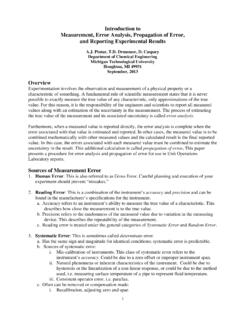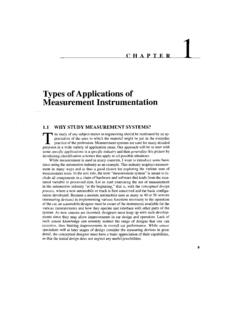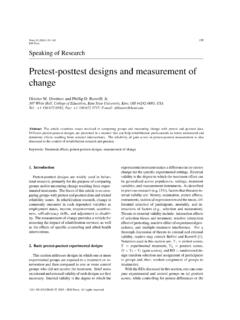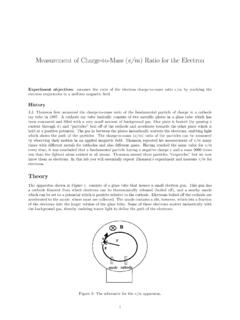Transcription of Introduction to Measurements & Error Analysis
1 1 Introduction to Measurements & Error Analysis The Uncertainty of Measurements Some numerical statements are exact: Mary has 3 brothers, and 2 + 2 = 4. However, all Measurements have some degree of uncertainty that may come from a variety of sources. The process of evaluating this uncertainty associated with a measurement result is often called uncertainty Analysis or Error Analysis . The complete statement of a measured value should include an estimate of the level of confidence associated with the value. Properly reporting an experimental result along with its uncertainty allows other people to make judgments about the quality of the experiment, and it facilitates meaningful comparisons with other similar values or a theoretical prediction.
2 Without an uncertainty estimate, it is impossible to answer the basic scientific question: Does my result agree with a theoretical prediction or results from other experiments? This question is fundamental for deciding if a scientific hypothesis is confirmed or refuted. When we make a measurement , we generally assume that some exact or true value exists based on how we define what is being measured. While we may never know this true value exactly, we attempt to find this ideal quantity to the best of our ability with the time and resources available. As we make Measurements by different methods, or even when making multiple Measurements using the same method, we may obtain slightly different results.
3 So how do we report our findings for our best estimate of this elusive true value? The most common way to show the range of values that we believe includes the true value is: measurement = best estimate uncertainty (units) Let s take an example. Suppose you want to find the mass of a gold ring that you would like to sell to a friend. You do not want to jeopardize your friendship, so you want to get an accurate mass of the ring in order to charge a fair market price. By simply examining the ring in your hand, you estimate the mass to be between 10 and 20 grams, but this is not a very precise estimate.
4 After some searching, you find an electronic balance that gives a mass reading of grams. While this measurement is much more precise than the original estimate, how do you know that it is accurate, and how confident are you that this measurement represents the true value of the ring s mass? Since the digital display of the balance is limited to 2 decimal places, you could report the mass as m = g. Suppose you use the same electronic balance and obtain several more readings: g, g, g, so that the average mass appears to be in the range of g. By now you may feel confident that you know the mass of this ring to the nearest hundredth of a gram, but how do you know that the true value definitely lies between g and g?
5 Since you want to be honest, you decide to use another balance that gives a reading of g. This value is clearly below the range of values found on the first balance, and under normal circumstances, you might not care, but you want to be fair to your friend. So what do you do now? Introduction to Measurements & Error Analysis 2 University of North Carolina To help answer these questions, we should first define the terms accuracy and precision: Accuracy is the closeness of agreement between a measured value and a true or accepted value. measurement Error is the amount of inaccuracy. Precision is a measure of how well a result can be determined (without reference to a theoretical or true value).
6 It is the degree of consistency and agreement among independent Measurements of the same quantity; also the reliability or reproducibility of the result. The statement of uncertainty associated with a measurement should include factors that affect both the accuracy and precision of the measurement . Caution: Unfortunately the terms Error and uncertainty are often used interchangeably to describe both imprecision and inaccuracy. This usage is so common that it is impossible to avoid entirely. Whenever you encounter these terms, make sure you understand whether they refer to accuracy or precision, or both.
7 Notice that in order to determine the accuracy of a particular measurement , we have to know the ideal, true value, which we really never do. Sometimes we have a textbook measured value, which is known precisely, and we assume that this is our ideal value, and use it to estimate the accuracy of our result. Other times we know a theoretical value, which is calculated from basic principles, and this also may be taken as an ideal value. But physics is an empirical science, which means that the theory must be validated by experiment, and not the other way around. We can escape these difficulties and retain a useful definition of accuracy by assuming that, even when we do not know the true value, we can rely on the best available accepted value with which to compare our experimental value.
8 For our example with the gold ring, there is no accepted value with which to compare, and both measured values have the same precision, so we have no reason to believe one more than the other. The only way to assess the accuracy of the measurement is to compare with a known standard. For this situation, it may be possible to calibrate the balances with a standard mass that is accurate within a narrow tolerance and is traceable to a primary mass standard at the National Institute of Standards and Technology (NIST). Calibrating the balances should eliminate the discrepancy between the readings and provide a more accurate mass measurement .
9 Precision is often reported quantitatively by using relative or fractional uncertainty: quantity measuredyuncertaint ty UncertainRelative= (1) For example, m = g has a fractional uncertainty of: to Measurements & Error Analysis Department of Physics and Astronomy 3 Accuracy is often reported quantitatively by using relative Error : valueexpected valueexpected - valuemeasured Error Relative= (2) If the expected value for m is g, then the relative Error is: Note: The minus sign indicates that the measured value is less than the expected value.
10 When analyzing experimental data, it is important that you understand the difference between precision and accuracy. Precision indicates the quality of the measurement , without any guarantee that the measurement is correct. Accuracy, on the other hand, assumes that there is an ideal value, and tells how far your answer is from that ideal, right answer. These concepts are directly related to random and systematic measurement errors . Types of errors measurement errors may be classified as either random or systematic, depending on how the measurement was obtained (an instrument could cause a random Error in one situation and a systematic Error in another).










